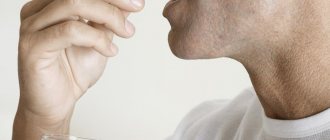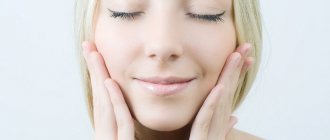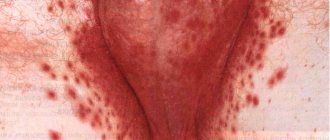- Xerosis, or dry skin. The tendency to it is inherited or occurs as a result of improper care, lack of water in the diet and, for example, when the protective skin barrier is damaged, which leads to increased transepidermal loss of moisture.
- Dermatoses. There is a whole group of diseases that provoke peeling: eczema, atopic dermatitis, allergic dermatitis, hyperkeratosis, etc. It is dangerous to fight them without medical supervision.
- Impact of adverse environmental factors. Dryness after a long walk in the cold or under the scorching sun, as well as after professional chemical peeling or dermabrasion, is inevitable if you do not use protective and restorative cosmetics.
- Some diseases of a non-dermatological nature. The skin on the face may become dry and flaky, particularly in a person with an autoimmune disease or hypovitaminosis. Consult your doctor to rule out internal causes of desquamation.
- Taking a number of medications. Peeling is caused, for example, by diuretics, as well as external agents, creams with high, therapeutic concentrations of acids or vitamin A derivatives.
- Age. Peeling of the facial skin and redness of the skin is observed in older people as a result of a decrease in the natural level of moisture in the dermis and epidermis, and a weakening of the skin’s protective mechanisms. This also happens in early childhood, since the epidermis is just learning to renew itself.
Why do women's faces peel?
In addition to the reasons already indicated, dermatologists associate peeling of the skin on a woman’s face with the onset of menopause or aggressive beauty practices. Thus, excessive use of peelings leads to a thinning of the hydrolipid barrier on the surface of the epidermis. And drying care dehydrates the skin, disrupting the normal mode of exfoliation of “dead” cells.
The habit of constantly following strict diets can also affect the condition of the skin.
Causes of peeling in men
It is believed that since an adult man’s sebaceous glands secrete more sebum than a woman’s, he should not have skin problems. However, regular shaving negates all the advantages: the blade leaves microdamages on the epidermis, and as a result, the integrity of the moisture-retaining hydrolipid layer is disrupted. Not shaving at all is also not an option, because the hairs themselves can cause irritation.
Peeling of the skin on the face in men often manifests itself for a more banal reason - perhaps the only aftershave balm for deep hydration is not enough in your case.
Let's summarize: even knowing why the skin on your face dries and peels, sometimes you cannot do without an experienced dermatologist. But there are some effective measures you can take on your own.
Structure of facial skin
It consists of three layers.
The uppermost layer is the epidermis, which is what our daily care mainly concerns. It bears the greatest load, as it is the first line of defense against negative environmental factors. The dermis goes deeper. It is in it that fibroblasts are located, the most important cells that synthesize collagen and elastin, structural proteins that maintain elasticity and prevent the formation of wrinkles. The care products we use do not penetrate this layer; it is affected by injection techniques. Next comes the subcutaneous fatty tissue, as well as connective tissue, which contains blood vessels and nerves.
If such a problem arises, then the first thing that needs to be established is how serious it is, and to what layer the changes have reached. If it concerns only the epidermis, then you need to select the appropriate care that matches the type of skin, the season and does not cause allergies. In some cases, a complex effect may be needed that will reach the dermis. A separate conversation about genetic or acquired diseases, which can be dealt with by taking special medications and using external agents.
Types and causes of the development of follicular hyperkeratosis
I. Congenital hyperkeratosis
It appears in childhood and is hereditary.
Treatment is symptomatic, recommended by a pediatric dermatologist.
II. Acquired hyperkeratosis
The most common form occurs for a number of reasons:
- Metabolic and endocrine disorders, especially with hypothyroidism and diabetes mellitus .
- Poor nutrition low in vitamins “A”, “E”, “C” and group “B” – hypovitaminosis .
- Skin diseases : tertiary syphilis, HIV infections, skin tuberculosis, fungal diseases of the feet.
- Autoimmune connective tissue pathologies (lupus erythematosus, scleroderma, etc.), allergies;
- Excessive exposure to various types of rays, prolonged physical exposure or contact with harmful chemicals, etc.
Main causes of dryness
The main one is the lack of moisture in the stratum corneum. It is a consequence of a decrease in barrier function due to disruption of the lipid structure. Gaps appear in the protective layers between the cells, so water is not retained.
This process may be accompanied by disturbances in sebaceous and sweating, and a deficiency of amino acids in epithelial cells, which ultimately leads to dehydration. To find out deeper and individual reasons, tests and necessary examinations are done.
Dehydration
A decrease in water content below the physiological norm causes various changes in metabolism. They can take on a different character, be of high or low severity, and this situation cannot be ignored. A change in the state of the epidermis is a clear manifestation of dehydration, but other disorders may also occur. But first of all, we pay attention to changes in appearance visible to the eye.
Peeling of facial skin, its causes and treatment is a long process, although sometimes the starting point of the disease may be the simplest. For example, the general loss of moisture in the body, which leads to a change in the water balance of all tissues. This condition has its own characteristics:
- A person feels not just dryness, but tightness.
- With dehydration, a violation of the structure of the epidermis can be expressed implicitly, however, the irregularities are clearly visible when decorative cosmetics are applied.
- Expression wrinkles on a dehydrated surface are easily smoothed out after applying a moisturizer.
Improper care for combination and oily skin
Owners of this type, in search of optimal products, choose those that contain alcohol or drying components. This leads to a hydro-lipid imbalance, and therefore causes a deterioration in the condition of the outer integument. When abrasive peelings are used in combination with such compositions, the epidermis can be injured, and then you will have to look for the answer to another question: what to do if your facial skin is peeling.
Achieving a reduction in sebum production does not mean solving the problem. It is important that there is balance and harmony in the work of the glands. After all, without lipids it is impossible to maintain hydration, especially since a dry surface is more easily injured.
Sensitive, thin skin
This epidermis is otherwise called reactive or overreactive. From the name it is clear that it responds to all existing irritants more clearly, which means that the consequences of the negative effects of the environment or allergens have to be dealt with longer and the use of individually selected means.
Congenital characteristics and natural location may be the main reason why the skin on the face peels.
Reactive epidermis is divided into groups:
- with a low barrier function, easily losing moisture;
- inflammatory type;
- neurosensitive.
It is important to remember that this feature can be the result of aggressive effects, such as sunburn. That is why protective recommendations cannot be neglected.
Freezing
Skin peeling at low temperatures is also called “cold allergy.” However, in the vast majority of cases this is hardly correct. We often notice changes due to the fact that before going outside we use moisturizing cosmetics or decorative products containing water. Moisture particles at low temperatures turn into ice crystals and injure the epidermis.
"Repurification"
Why does the skin on the face of women, men, and children peel off after washing, and how to treat it in this case? After all, it would seem that such procedures should saturate it with moisture, but the effect is often the opposite. It's all about excess cleansing:
- If you use alcohol-containing products before washing, they can dry out the epidermis, and simply washing will not be enough to restore the balance.
- Aggressive soap with an incorrectly selected pH violates the integrity of the lipid barrier.
- Trauma from scrubs and exfoliants used for home cleansing ultimately causes discomfort and tightness.
Excessive peeling
Incorrectly selected, overly active abrasive compounds can cause peeling. A slight deterioration in condition after exfoliation is within normal limits. However, severe and persistent dryness is a sign that they are being done incorrectly. After manipulation, it is recommended to apply to the face:
- fat cream;
- Panthenol;
- thermal water.
Adverse external factors
If your facial skin is very flaky, the reason may be:
- using incorrectly selected rough cleansers;
- UV rays: solar radiation penetrates to the deep layers of the dermis, including destroying collagen and elastin fibers;
- overdried, overheated indoor air, which causes dehydration of both the outer skin and mucous membranes.
Decorative cosmetics with dry texture
Mistakes when choosing make-up, as well as creams, serums and lotions, are becoming a common cause of dryness. In particular, we must remember that the abuse of products containing mineral particles, including powder, blush and shadows, can negatively affect the relief. This kind of makeup has the property of absorbing moisture and ultimately leading to dehydration, not from the inside, as in most cases, but from the outside.
Using facial products around the eyes
This delicate area is highly sensitive. It needs the closest care because it is very thin and there is no fatty tissue underneath. That is why, to avoid peeling, you need to use products designed to care for this specific area. They contain active components in high concentration.
Allergies and other diseases
If questions arise about how to remove peeling skin on the face and how to treat it, then the doctor will definitely find out if you have any allergic reactions. It is possible that the change in condition is associated with an allergy to foods, pollen, dust, or the composition of caring cosmetics. It is believed that contact dermatitis is one of the main reasons for the deterioration of the condition. We must remember that the body’s response may be slow, but it is not always possible to directly associate the manifestation of a problem with contact with a certain substance.
During the examination, the dermatologist must say exactly what kind of disease the patient has, because it can be simple contact, seborrheic or atopic dermatitis.
Diagnosis of the causes of peeling skin on the face
You need to do some research first:
- collecting anamnesis to identify hereditary factors (many problems have a genetic basis) and characteristics of ongoing care;
- visual inspection;
- differential diagnosis to exclude diseases of internal organs and systems that lead to changes in the epidermis;
- skin allergy tests to determine the presence of specific reactions;
- bacterial sowing;
- scrapings and so on.
Based on the results, a clinical picture is obtained that the doctor uses.
Diathesis
Redness and dryness in a child are most often referred to by this term. As a rule, this is a general designation of the baby’s tendency to illness or severe reactions to products or care products.
In most cases, this is an analogue of allergic atopic dermatitis in an adult. Initially, it occurs due to errors in the mother’s diet, which affect the composition of breast milk.
When parents ask why the skin on the face peels, how to treat it and how to get rid of dryness on the body, the pediatrician prescribes treatment, and after an examination he will reveal the cause of the peeling. Recommendations will concern not only special cosmetics, but also the behavior and nutrition of the mother. In particular, you will have to exclude those dishes that cause a reaction in adults; bathing products without dyes, preservatives and fragrances are prescribed. The baby may be recommended to take the sorbent in a form that can be given to infants. It quickly removes allergens from the body and allows you to analyze which product the baby developed redness after eating.
Psoriasis
This is a chronic disease that causes patients great discomfort during exacerbations. As a rule, it manifests itself in people with a family history, but following a number of rules allows you to avoid its obvious manifestations.
Factors that provoke pathology include:
- Long-term negative impact of the environment, including sun, frost, and so on.
- The use of rough scrubs and traumatic cosmetics.
- Washing with regular soap.
- Using hair dyes that cause irritation on the scalp.
- Allergic reactions.
- Eating spicy, salty, fatty foods, as well as alcohol.
What to do to prevent the skin from peeling with psoriasis, the doctor recommends. The treatment program includes the use of hormonal drugs that cannot be purchased independently. Therapy should also include keratolytics and emollients, anti-inflammatory drugs.
Avitaminosis
The most important vitamins for the skin include:
- B1 – relieves itching and participates in the metabolism of proteins, lipids, and is responsible for the synthesis of connective tissue elements.
- B2 – improves nutrition, is part of respiratory enzymes, stimulates regeneration.
- B5 is a component of redox processes.
- Pantothenic acid – has a protective effect, relieves inflammation.
- B6 – its deficiency can be one of the main causes of flaking of the skin on the face; it is prescribed for various dermatoses.
- Folic acid - indicated for hyperkeratosis, patients with psoriasis, relieves itching.
- Nicotinic – needed in reparation processes (not prescribed during periods of sharp exacerbation of allergic reactions).
- B12 is a remedy for photodermatoses, neurodermatitis, and so on.
- H (biotin) – its deficiency is accompanied by dry skin and the appearance of scales.
Mycosis
Fungal infections occur quite regularly today, including due to weakening compliance with sanitary and hygienic standards. With these diseases, “flakes” look like small lesions, and scales also appear in the hair. The spots can be pink or red, in their center the epidermis dries out. Small areas of the lesion merge as they progress, causing serious discomfort. Sometimes hair is affected and becomes thin and brittle. Most often, infection occurs from animals.
Seborrheic dermatitis
This disease is also called eczema and is a common cause of irritation on the face. The chronic disease is characterized by inflammation, slight itching, and the skin on the cheeks begins to peel off. It is common among both adults and children, including sometimes affecting newborns.
The causes of the disease include:
- decreased immunity;
- heredity;
- changes in hormonal levels;
- stress.
As a rule, the areas of greatest damage are in the eyebrows, on the bridge of the nose and in the nasolabial folds. A doctor should determine what will help with peeling skin on the face.
Ichthyosis
With this diagnosis, the process of keratinization is disrupted. The disease is hereditary in nature, and scales appear on the surface (hence the name). Some areas thicken, while in others, on the contrary, the epidermis becomes very thin. And improper absorption of vitamin A causes keratin accumulation and hardening. In severe cases, areas of inflammation and blisters appear, and a violation of the protective barrier makes the outer skin very vulnerable to infections.
Patients with scaly dermis may also have other problems. Perhaps their thermoregulation is impaired, their metabolism is slowed down, and the activity of enzymes involved in oxidative reactions is increased. This leads to disruptions in the functioning of the endocrine system.
There is currently no treatment, since the source is genetic mutations. However, care rules must be followed: constant moisturizing of the epidermis, keratolytic therapy, and dosed ultraviolet irradiation are necessary.
What is follicular hyperkeratosis
Follicular hyperkeratosis is a common dermatitis caused by excessive growth of the stratum corneum of the skin, impaired desquamation of the epidermis and blockage of the mouths of the follicles with epidermal scales.
There is a violation of the release of sebum to the surface of the skin and aseptic inflammation. Visually, this gives the “goose bumps” effect.
How to get rid of dry skin on the face and remove imperfections: how to treat peeling
Many people try to solve the problem with home remedies, recipes, or use creams that they buy in a regular store. However, descriptions and recommendations on the label are often not enough - depending on the underlying processes in the body, qualified assistance from a dermatologist, allergist or cosmetologist may be required.
As practice shows, approximately 85% of patients ask this question. To effectively cope with discomfort, a combination of anti-inflammatory and exfoliating agents is optimal. Also recently, the role of steroids in therapy has been growing. And in the presence of concomitant diseases that affect the condition of the epidermis, doctors of several specialties must work in close collaboration.
Clinical picture
Visually: small reddish rashes, “goose bumps”, dense nodules are localized at the very base of the hair follicle.
to the touch .
Localization : most often on the shoulders, hips, face and buttocks.
In the generalized form of follicular hyperkeratosis, extensive damage to the trunk and extensor surfaces of the extremities is observed.
Diagnostics:
The diagnosis is made by a dermatologist based on a visual examination; specialized techniques are not required.
It is necessary to distinguish follicular hyperkeratosis from acne. In the case of hyperkeratosis, the rashes on the face are dry, rough to the touch, small and uniform in size.
Tools Overview
It is known that health and beauty are guaranteed by competent three-step care, which includes:
- cleansing;
- toning;
- hydration.
At each stage you need to use appropriate cosmetics; this is the best combination that answers the question of what to do if the skin on your face is constantly peeling.
In therapy today, products made on the basis of placenta extract are increasingly used. One of them is the Japanese placental drug Laennec. Being a hepatoprotector and immunomodulator, it affects the state of the body's defense mechanisms, and therefore reduces the severity of allergies. It includes:
- Cytokines and peptides that provoke an immunological reaction.
- More than 36 cell growth factors.
- 18 amino acids, including essential ones, to prevent unwanted cellular oxidation and prevent the action of free radicals.
- About 100 protective enzymes and 40 vital minerals.
- Vitamins B1, B2, B6, B12, C, D, E.
- Hyaluronic acid to optimize water balance and moisture retention.
Experience has already been accumulated in the successful use of the drug in the treatment of atopic dermatitis. Cytokines included in Laennec activate cell metabolism and prevent the development of fibrosis.
Cleansing
An important stage, without which maintaining health is impossible. Timely removal of dead cells, excess sebum, cosmetics, dirt particles, and opening of pores normalize breathing and renewal of the epidermis. Let's list the main steps on what to do when the skin on your face is peeling:
- Wash your face with warm water.
- Use gentle products selected according to your skin type.
- Remove eye makeup with a special milk designed to care for delicate and sensitive areas.
- Blot rather than wipe your face.
- Use lipid-restoring drugs and formulations with hyaluronic acid.
Peeling should only be done by a cosmetologist, who will select the components specifically for individual sensitivity. Independent use of acids can become a trigger for the appearance of new “peels”.
Serums
This is one of the essential treatments for flaky skin. They contain active substances in high concentrations, and when applied to a well-cleaned surface, they work especially effectively. To moisturize, use cosmetics containing hyaluronic acid, pay attention to its shape. It is believed that from the outside it does not penetrate the epidermal barrier, but low molecular weight is most likely able to overcome it.
Creams/emulsions/balms
What to do if the skin on your face is peeling - the reasons that the doctor will find out will suggest the direction of possible therapy. And at home, you can use compounds that increase barrier properties and prevent moisture loss. Typically they contain:
- substances that form a protective film;
- probiotics;
- vitamins;
- oils
Summer care goals for combination skin
When choosing products for the care of combination skin in the summer, it is necessary to take into account not only the impact of provoking factors, but also the reactions of different areas of the facial skin to them.
- Regulate the functioning of the sebaceous glands in the T-zone . It is in summer that activity is most increased, which leads to blockages and subsequently rashes.
- Regular elimination of hyperkeratosis , which inevitably appears on all areas of the facial skin. You need a product that works effectively and delicately and does not dry out the skin of the entire face.
- Moisturizing the skin - it is important to monitor the water balance of the skin, preventing dehydration.
- Protecting the skin from the sun - prevents dehydration, photoaging and pigmentation.
What folk remedies can be used
At home, the main principle is to do no harm, choose the softest and most gentle compositions.
For example, at home you should not use abrasive peels, but rolls that do not injure you in any way. They collect dead epidermal cells due to the content of cellulose and starch, which do not scratch or leave microcracks.
When it comes to creams, it is better to take those intended for home care. When going outside, be sure to apply sunscreen.
If we talk about masks based on fermented milk products or oils, cosmetologists recommend trying them first on the skin of your hands. All homemade cosmetics can cause an allergic reaction, which will only worsen the consequences.
How to get rid of a problem from a cosmetologist
Before you go to a specialist, we recommend that you find out whether he has a license and the appropriate qualifications. Unfortunately, recently offices have often opened in which the situation can worsen: cosmetology is a branch of medicine, and conventional courses for correct diagnosis and choice of treatment are not enough.
At your appointment, a certified professional cosmetologist will recommend how to get rid of peeling skin and what procedures can be carried out for this. Among them:
- Special corrective care with cosmetics that penetrate the epidermal barrier.
- Paraffin therapy – liquid warm paraffin creates a greenhouse effect that helps moisturize the skin.
- Biorevitalization is an injection technique for introducing preparations based on hyaluronic acid into the upper layers.
- Gentle acid peeling, which is indicated when the cause of dryness is not a serious systemic disease.
Characteristics and features of combination skin type
When determining your skin type, it is important not to confuse it with dehydrated skin due to exposure to any external factors.
Main characteristics of combination skin
The main feature is that the skin on different parts of the face behaves differently: the T-zone has signs of an oily skin type, while the remaining areas have signs of normal and even dry skin.
- Increased activity of the sebaceous glands in the T-zone (forehead, nose and chin);
- In the T-zone, the pores are enlarged, prone to the formation of comedones and even inflammatory elements of acne;
- On the cheeks, the skin is prone to dryness, tightness and even flaking.
It is necessary to distinguish between dry and dehydrated skin , because... The presence of peeling on the cheeks is not proof that the skin there is dry.
- With dry and normal skin, pores are not visible, but with oily and dehydrated skin they are quite obvious.
- The presence of rashes is also typical for oily skin types and practically does not occur in dry skin types.
- The appearance of dry and tight skin in summer or winter – i.e. when the climate changes, it is a sign of dehydration. Dry skin is always dry.
It is in the summer, especially at seaside resorts, that in the absence of proper care, a state of dehydration quickly occurs.
Balanced nutrition as a means of combating
A calculated diet is one of the important conditions for maintaining beautiful and healthy skin. It should be enriched with fish dishes that contain omega-3 fatty acids, as well as vegetable oils.
Avocado contains beneficial components; it helps retain moisture in the epidermis. The condition is improved by substances found in greens and green vegetables. The nutritional components contained in eggs have a beneficial effect: amino acids, vitamins, folic acid.
Laennec drug and super-thin injection needles Nanoneedle
Laennec - injection solution No. 10
Curacen / Curacen
Nanoneedles with ultra-thin walls 30G
Nanoneedles with ultra-thin walls 33G
Hyperkeratosis
A huge number of “dead cells” layered on the surface of the skin
The stratum corneum is a layer of cells (keratinocytes) on the surface of the skin - a “thin line” separating the body from the environment; beyond this line the outside world begins.
Normally, keratinocytes desquamate (exfoliate) from the surface of the skin on a constant basis, imperceptibly, without burdening or affecting the quality of life .
Hyperkeratosis - thickening of the stratum corneum , occurs due to excessive layering of keratinocytes (horny masses), and is a consequence of various skin conditions:
Untidy “unwashed” skin
Shine during the day, comedones, enlarged pores, inflammatory rashes (from single to numerous) are a consequence of hyperfunction of the sebaceous glands (excessive sebum secretion).
Keratinocytes are saturated with this secretion, sticking together, which leads to a deterioration in the desquamation process.
Essentially, in this case, an increased amount of “dead” cells, saturated with sebum, . Add to this wonderful composition the remnants of ineffectively removed makeup... More details
Hyperkeratosis shows age
The cells of the stratum corneum (keratinocytes) connect each other with desmosomes - special bridge structures that hold dead keratinized cells on the surface of the skin. Normally, when these connections are disrupted, the keratinocyte desquamates.
From the age of 30, the duration of stay of keratinocytes on the surface of the skin increases: every year by one day!
This occurs due to the strengthening of desmosomes. It becomes more difficult for keratinocytes to slough off and leave the surface of the skin. It’s hard to imagine that the life cycle of a skin cell depends so much on age :
- 30 years - average 28 days
- 40 years - 38 days,
- 50 years - 48 days,
- 60 years - 58 days...
This means that there are a huge number of dead cells on the surface of the skin that simply cannot leave the surface of the skin ! More details
Hyperkeratosis as a reaction to excess UV rays
Everyone has been in a situation where, after a long stay on the beach, the skin becomes dry and tight, flaking. ..
An increase in the thickness of the stratum corneum with excess UV rays is a protective reaction of the body that prevents the harmful effects of sunlight on the skin. The thickened stratum corneum, in this case, works on the principle of mechanical SPF .
Fortunately, the rehabilitation period after a beach holiday is temporary. In just a couple of professional procedures, a cosmetologist will be able to solve the problem of hyperkeratosis against the background of hyperinsolation.
However, for those who like to sunbathe excessively, photoaging will be a guaranteed attribute in the future.
The correct process of formation of horn cells (keratinization) ensures:
- The consistency of the skin barrier function (protection),
- Absence of skin diseases (psoriasis, atopic dermatitis, mycosis..)
- Aesthetic component (neat young skin with even texture).
DermaQuest - perfectly clean, smooth skin, radiating beauty and health!
Let's sum it up
If you experience symptoms of deterioration in the condition of the outer skin, including redness and itching, we recommend that you consult a doctor without delaying. Make an appointment with a dermatologist, dermatovenerologist, cosmetologist (beauty salon specialists do not always have higher education, so we advise you to make an appointment at the clinic). The sooner a specialist determines the reasons for the change, the faster adequate treatment will be selected, relapse prevention will be provided, and the question of how to get rid of peeling on the skin will be answered.










